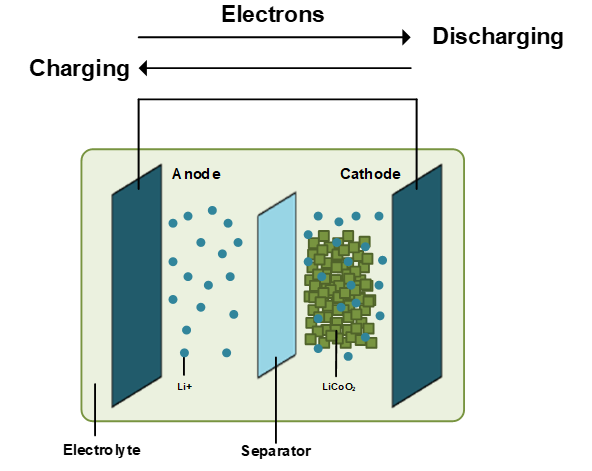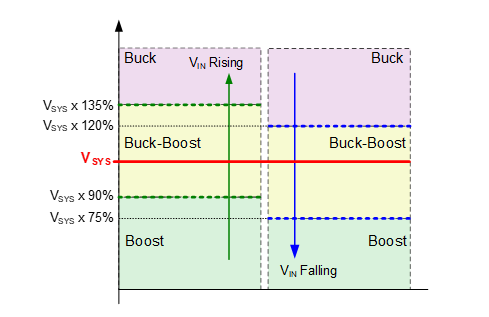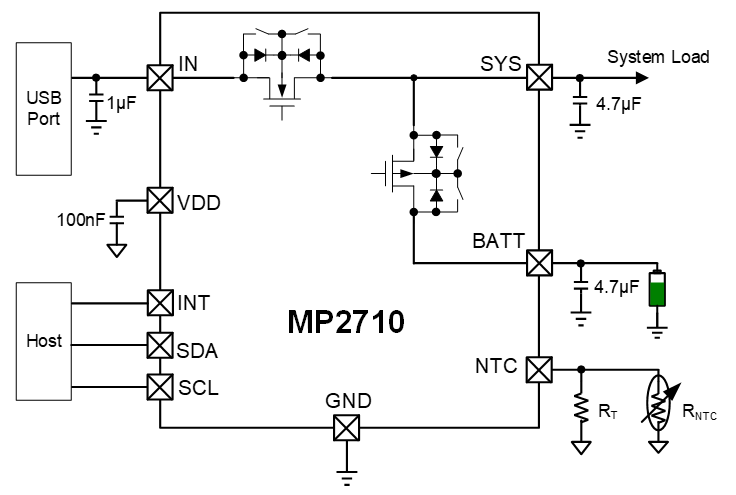An Introduction to Batteries: Components, Parameters, Types, and Chargers

Get valuable resources straight to your inbox - sent out once per month
We value your privacy
Introduction
Due to their ability to store and transfer energy while on the go, batteries have become a commonplace item that can be found in almost all electronic products we use daily. Batteries save lives when portable medical equipment is required, and provide plentiful everyday uses in applications such as headphones and portable power tools. Rechargeable batteries can rely on power banks to be charged when there is no immediate power source.
The article will discuss a few basic battery fundamentals by introducing basic battery components, parameters, battery types, and MPS’s battery charger ICs designed for rechargeable batteries.
Battery Components
Batteries are comprised of several components that allow batteries to store and transfer electricity. To charge and discharge batteries, charged particles (ions and electrons) must flow in particular directions and through particular components. Although batteries can vary depending on their chemistry, they have a few basic components:
- Cathode: The cathode is the positive electrode (or electrical conductor) where reduction occurs, which means that the cathode gains electrons during discharge. The cathode typically determines the battery’s chemistry and comes in a variety of types (e.g. lithium-ion, alkaline, and NiMH).
- Anode: The anode is the negative electrode where oxidation occurs, which means that the anode loses electrons during discharge. Anodes are typically a conductive material, such as a metal.
- Electrolyte: The electrolyte allows ions to flow between the anode and cathode. This medium can be a solid, liquid, or even a gel. Electrolytes carry the ions that allow for electrochemical reactions, and the type of electrolyte changes depending on the cathode. For example, the electrolyte in lithium-ion batteries is often a liquid or gel (such as for lithium-polymer batteries).
- Separator: Separators are a porous material that prevents direct contact between the anode and cathode, as contact between these components could lead to catastrophic outcomes, resulting in the battery catching on fire or even exploding. The separator allows ions to flow.
- Collector: Like its name suggests, the collector collects current. It is a conductive material that allows electrons to flow between the electrode and the circuit. Collectors are typically metal or carbon-based, and are connected to both the anode and cathode.
- Terminals: The battery’s terminals are where the battery’s metal contacts connect the battery to the external circuit. Typically, the terminals are located on either end of the battery. While legacy batteries typically have two terminals (one at the cathode and one at the anode), more recent batteries can have more than ten terminals.
Figure 1 shows a battery diagram for an Li-ion battery. Note that other battery chemistries may have different or additional components for operation. For example, Li-ion batteries have Li-metal oxides between the cathodes and the porous separator, then Li-metal carbon between the separator and the anode. These ion transfers all occur within an electrolyte, such as a gel or liquid.

Figure 1: Li-Ion Battery Diagram
When a Li-ion battery is charging, positive lithium ions flow internally from the cathode to the anode; at the same time, electrons flow externally from the cathode to the anode. When the battery is discharging, the lithium ions and electrons flow in the opposite direction.
Battery Parameters
When choosing a battery, there are multiple parameters to consider and understand, especially since these specifications change for every battery type. These parameters include, but are not limited to:
- Chemistry: Different battery chemistries have different characteristics, such as those related to voltage, capacity, and energy density. Some of these chemistries will be described below, but for a more in-depth understanding of battery chemistries, learn how battery chemistries can affect charger selection.
- Voltage: The battery voltage is the voltage difference between the anode and cathode. Different battery chemistries have different rated voltages; for example, Li-ion cells have a rated voltage of 3.7V, while alkaline cells have a rated voltage of about 1.5V. Higher voltages result in higher capacity and output power.
- Capacity: A battery’s capacity refers to the amount of electrical energy that it can store and deliver. The capacity indicates the total amount of charge that is transferred during a complete charge or discharge cycle. Batteries with a higher capacity do not need to be charged or replaced as quickly as batteries with a lower capacity.
- Cycle life: The cycle life describes how many times a rechargeable battery can be charged and then discharged before its capacity permanently drops to a certain percentage.
- Energy density: For batteries, energy density measures how much energy can be stored per unit of volume. Batteries with higher energy densities can store more energy in a smaller package, which makes them well-suited for space-constrained applications.
- Self-discharge rate: The battery’s self-discharge rate is the rate at which the battery loses its charge when it is not in use. If you have ever wondered why an electronic device does not turn on after a period of inactivity, this is because the battery self-discharged until the battery lost enough charge to no longer support device function.
- Power: A battery’s power rating determines how much power it can deliver to the connected loads. It is the summation of the battery’s voltage and the allowed maximum discharge current of the battery.
- Efficiency: In this scenario, efficiency refers to the ratio of electrical energy that is delivered during discharge compared to the electrical energy supplied during charge. Batteries with a higher efficiency do not lose as much energy or dissipate as much heat, which means they are able to last longer.
Battery Types: Advantages and Disadvantages
There are two main types of batteries: disposable and rechargeable (see Figure 2). Between these two battery types, there are many battery chemistries that dictate parameters, such as capacity, voltage, and energy density.
Disposable batteries are batteries that can only be used once, then must be replaced after they have been fully discharged. Meanwhile, rechargeable batteries can be recharged and used multiple times even after being completely discharged.

Figure 2: Disposable Batteries (Left) and Rechargeable Batteries (Right)
Table 1 shows a comparison of the battery chemistries that will be described in greater detail below.
Table 1: Stepper Motors vs. Brushed DC Motors
| Chemistry | Nominal Voltage (V) | Capacity (Ah) | Cycle Life | Energy Density (MJ/L) | Monthly Self-Discharge Rate (% of Capacity) |
| Alkaline (Disposable) | 1.5 | 0.7 to 1.8 | - | High (0.90 to 1.56) | Low (0.17) |
| Zinc-Carbon (Disposable) | 1.4 to 1.7 | 0.3 to 7 | - | Low (0.33) | Low (0.32) |
| Lead-Acid (Rechargeable) | 12 | 30 to 100+ | 500 to 100 | Low (0.22 to 0.27) | High (3 to 20) |
| Li-Ion (Rechargeable) | 3.7 | 0.5 to 4+ | 500 to 1,000 | High (2) | Medium (5 to 10) |
| Nickel-Cadmium (NiCd) (Rechargeable) | 1.2 | 1 | Up to 800 | Low (0.36) | High (20) |
| Nickel-Metal Hydride (NiMH) (Rechargeable) | 1.2 | 0.3 to 14 | Up to 500 | High (1.44) | Very high (30) |
Disposable Batteries
Disposable batteries are pre-charged and ready to use, retain their charge for years when unused, and are built for particular applications, which means they do not require maintenance. However, disposable batteries must be replaced as soon as they are used, which can be inconvenient, such as when traveling, as this means either storing additional batteries or purchasing new batteries. In addition, battery disposal is an environmental challenge, as the metals and materials in these batteries can harm the environment when not disposed of properly.
A few disposable battery types and their chemistries are listed below.
- Alkaline batteries: Alkaline batteries (e.g. AA, AAA, C, and 9V) are incredibly common and used in many day-to-day objects, such as flashlights, toys, and remote controllers. Alkaline batteries are simple to use and available in most stores, plus they have a relatively low self-discharge rate.
- Zinc-carbon: Zinc-carbon batteries are similar to alkaline batteries in that they have a relatively low self-discharge rate and must be replaced, but they have a lower energy density and typically do not last as long when in use. Because of this, they are often used in devices that have low current consumption, such as clocks and radios.
Rechargeable Batteries
Although rechargeable batteries must be carefully selected for their application, they are better for the environment, cost-effective, and typically provide more power than disposable batteries. Rechargeable batteries are also particularly useful while traveling without a direct power source because they can be recharged using a power bank.
- Lead-acid: Lead-acid batteries are a rechargeable, well-established battery type often used in applications such as uninterruptible power supplies (UPS) because they can deliver high currents and provide reliable safety. Although these batteries are cost-effective, they have a lower energy density than other battery types and are heavy, which means they are not recommended for mobile applications.
- Lithium-ion: Li-ion batteries are rechargeable batteries often used in portable applications, such as smartphones and laptops. Because they have a high energy density and low self-discharge rates, Li-ion batteries have a long shelf life and charge quickly. However, they require safety features to prevent catching fire or even exploding under suboptimal conditions. Similar battery types include Li-polymer batteries and lithium iron phosphate (LFP) batteries.
- NiMH/NiCd: NiMH and NiCd batteries are relatively similar battery types and are used in applications such as cordless phones, power tools, and digital cameras. Both battery types can be recharged between 500 and 800 times. NiMH batteries have a very high energy density, and both battery types have a similar nominal voltage. However, due to environmental concerns with cadmium, NiCd batteries are becoming less common.
Battery Charger ICs for Rechargeable Batteries
For environmentally friendly, highly versatile rechargeable batteries, it is vital to have a battery charger IC that is compatible with the battery and system specifications. A battery charger IC can benefit a battery by providing protections and regulating the charging process. These benefits are described in greater detail below.
- Battery protection: Certain battery chargers execute protections that are able to safeguard the battery, and battery charger. Protections include over-voltage protection (OVP), under-voltage protection (UVP), over-current protection (OCP), and over-temperature protection (OTP), which prevent the battery and battery charger from potentially dangerous conditions that could result in a fire or explosion. In addition to battery charger ICs, MPS offers comprehensive battery monitors and protectors such as the MP2790 and MP2787.
- Charge regulation: Battery chargers, such as the MP2760 and MP2651, regulate charge by monitoring the battery’s voltage, current, and temperature during the charging process. The charger can adjust the current and voltage settings to match the battery’s requirements and ensure the battery does not overcharge or over-discharge to protect the battery’s lifespan.
- Communicating with the BMS: Battery charger ICs can communicate with the BMS through communication interfaces to exchange data regarding the battery’s status, set protection thresholds, and force the battery charger into certain states that may affect the battery.
The following section will introduce MPS battery chargers; but there are many other battery charger ICs that can be used for a wide range of battery chemistries.
MPS Battery Charger ICs
MPS offers a wide range of battery charger ICs that can be used in medical devices, smartphones, video game controllers, drones, notebooks, power tools, wearables, Bluetooth speakers, smart homes, and electric vehicles (EVs).
The MP2760 is a buck-boost battery charger IC that can be used in notebooks and tablets, and supports USB power delivery (PD) among other charging settings. This charger can accept up to 22V of input voltage (VIN) and provides protections for both the charger and battery (such as voltage and temperature protections), as well as a timer to prevent charging a dead battery. Depending on the system voltage (VSYS), the MP2760 can flexibly transition between boost, buck-boost, and buck mode to control input voltage (VIN) and provide a smooth charging of the battery regardless of VIN variations (see Figure 3).

Figure 3: The MP2760’s Mode Transitions
The MP2760 is part of a battery charger solution module with a dual-role port (DRP) USB Type-C port for bidirectional operation. It can be used in speakers, tablets, point-of-sales (POS) systems, drones, and cameras.
As a switching charger, the MP2760 is ideal for applications with medium to high currents — including smartphones, tablets, and speakers — and it can be used across a wide VIN range.
However, there are also linear chargers, which can be used for low-current applications with fewer external components, such as those for portable devices (e.g. Bluetooth earbuds and smartwatches). The MP2710 is a configurable linear charger with power path management to ensure that the battery does not deeply discharge. This charger is recommended for space-constrained applications due to its tiny WLCSP-9 (1.85mmx1.85mm) package. In addition to regulating charge, the MP2710 also provides protections such as short-circuit protection (SCP), to ensure the battery is not damaged from an excessively high current, and under-voltage lockout (UVLO), which protects the battery and system when the battery voltage drops too low.
Figure 4 shows the MP2710’s typical application circuit.

Figure 4: MP2710 Typical Application Circuit
Conclusion
The article explored the basics of batteries, such as their general components, useful parameters (e.g. voltage, capacity, and energy density), battery chemistries, the differences between disposable and rechargeable battery types, and battery charger ICs such as the MP2710 and MP2760. These chargers can work with commonly used lithium-ion batteries for applications including notebooks, power tools, and wearables.
Battery chargers are necessary to ensure safe and reliable battery operation while optimizing for battery lifespan. MPS’s battery charger ICs cover a wide range of applications, such as switching chargers, linear chargers, and chargers that can support up to 7 cells in series.
_______________________
Did you find this interesting? Get valuable resources straight to your inbox - sent out once per month!
Technical Forum
 Latest activity 13 hours ago
Latest activity 13 hours ago
 6 Comments
6 Comments
 Latest activity 3 days ago
Latest activity 3 days ago
 6 Comments
6 Comments
 Latest activity 3 days ago
Latest activity 3 days ago
 4 Comments
4 Comments





Log in to your account
Create New Account